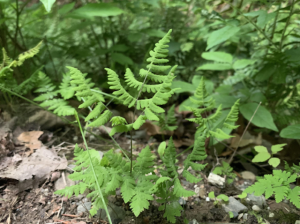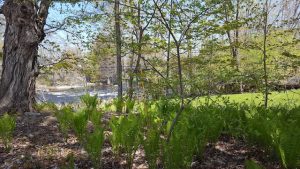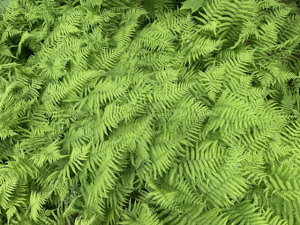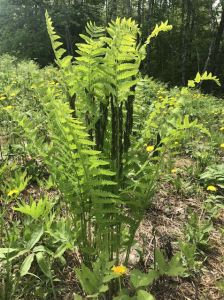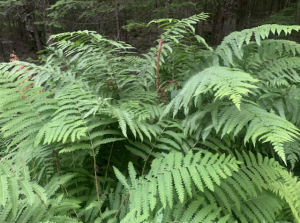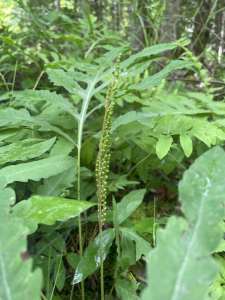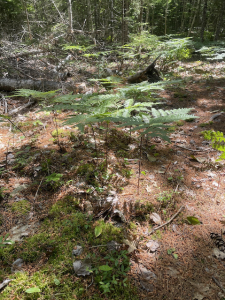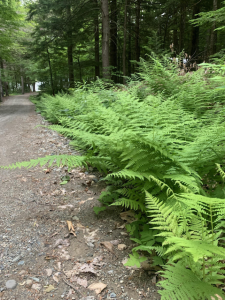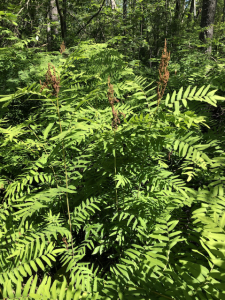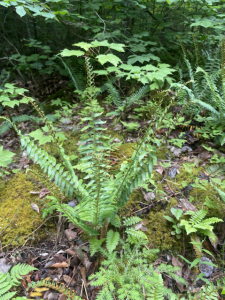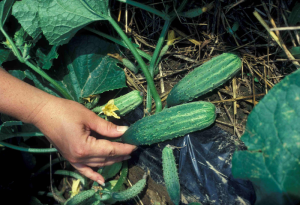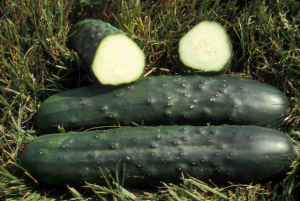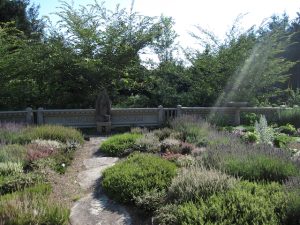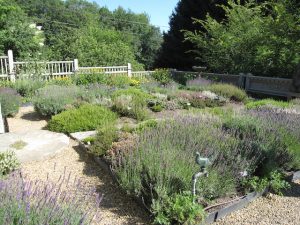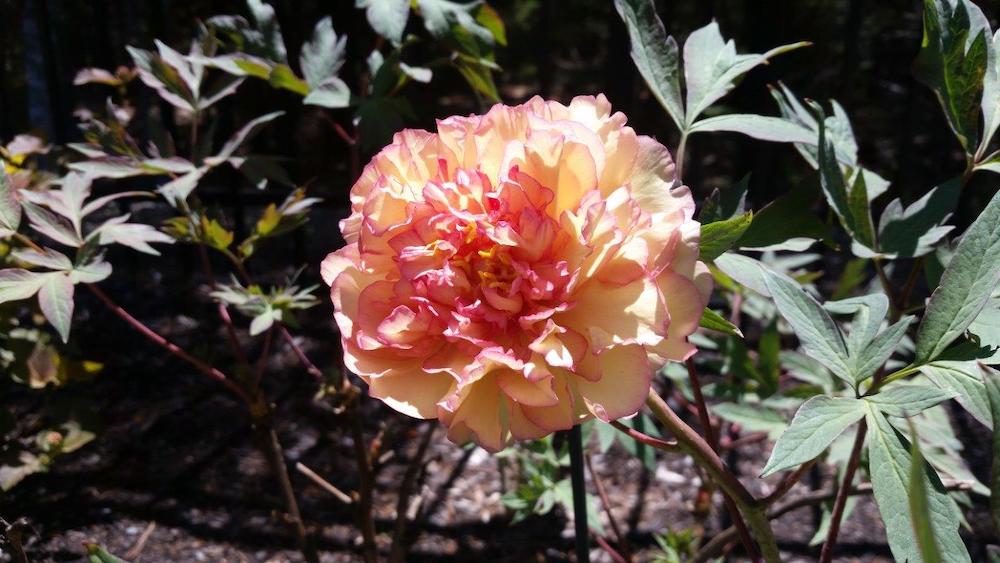
Maine Home Garden News — July 2022
In This Issue:
- July Is the Month to . . .
- Ferns for the Home Landscape
- July Maine Garden Harvest Guide
- Maine Public Gardens: Garland Farm, Bar Harbor, ME
- Northern Mockingbird
- PFAS and Your Home Garden
July Is the Month to . . .
By Sandra Mitchell, Penobscot County Master Gardener Volunteer
For goodness sake, July is the month to do so much that it is hard to know where to start! Perhaps I should begin with “July is the month to do everything I didn’t get done in May and June…….”? For those who are better organized, here are a few tasks not to forget this July.
In my world, July is about watering, weeds, and bugs. I am awful at weeding, which hides the bugs, and have to hand pump and carry water, which makes it a memorable experience.
First – weeding. Remember that the weeds rob your plants of valuable food, water, and light. Take a little time every day to pull out annual weeds, preferably before they set seed, and dig up the perennial invaders. Mulch will help to keep weeds down and moisture in. To make next year easier, consider putting down plastic to solarize an area in the hot summer sun. Leave it on until you’re ready to plant next season. You’ll have a clean slate to work with and less weed pressure in the long run.
Bugs! Ok, we survived most of the blackfly season and some of the mosquito season. Ticks are a perennial problem – don’t forget about the awesome resource at the University of Maine Tick Lab. If you find an attached tick, send it to the lab to get the ultimate revenge on tick-hood and data for managing your health.
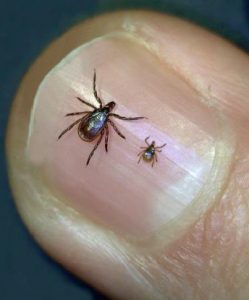
Your garden dislikes slugs as much as you hate deer ticks. These little boogers can do all kinds of damage, quickly. Beer traps work, as do swaths of cardboard over moist soil. In the morning you can collect a large harvest of slugs to delight your chickens and ducks. Sometimes I allow the ducks into the garden early in the morning and by noon, I’m pretty slug-free. Of course, a few plants are flattened as well, but this seems a small price to pay! I do not recommend this method with chickens, however, if you want any plants left intact. My flock, at least, like the plants as much as the slugs.
Those nasty Japanese beetles are another July worry. Pheromone traps only seem to attract my neighbor’s beetles. The neighbors appreciate it, but my plants don’t. Handpicking is likely the most effective control, although labor-intensive. The beetles move slowly early in the day and with repeated patrols, you can make a big dent in the population.
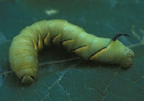
Of course, we’ve all had lovely experiences with hornworms. The moth stage is beautiful, but the damage to the garden from the worms is not. Once again, handpicking is the way to go. I find the piles of frass (polite term for insect poop) easier to spot than the hornworm itself. And once again, my taller ducks are happy to volunteer for worm hunting. Those of you who keep bearded dragons also have a ready outlet for those hornworms. A favorite in my reptile book. Spread the love…..
Another big bug to watch out for is the Colorado potato beetles. Did you know they will also go after tomatoes and eggplants? Removing the egg masses before they hatch will really cut down the problem. Here’s a quick primer, Colorado Potato Beetle.
Don’t forget to thin root crops like carrots, onions, and beets. And all of those open areas left by your July pea harvest? Fill them in with direct seeding of kale, carrots, chard, beets, broccoli, and spinach. It’s not too late to plant another few rows of beans, or a fall crop of lettuce. And if you don’t want to replant, put in a cover crop like buckwheat or oats to make the most of the space you have. See, Planting Chart for the Home Vegetable Garden.
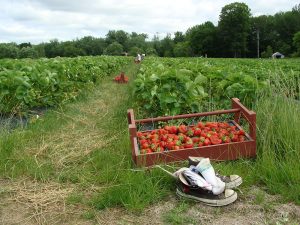 Now, I know your fingers are bright red from an afternoon at the local pick-your-own strawberry farm. But before you scrub up those hands, don’t forget a little TLC on your own strawberry beds. Super tips can be found here, Bulletin #2067, Growing Strawberries.
Now, I know your fingers are bright red from an afternoon at the local pick-your-own strawberry farm. But before you scrub up those hands, don’t forget a little TLC on your own strawberry beds. Super tips can be found here, Bulletin #2067, Growing Strawberries.
Are you wondering what to do with all those strawberries or the other bountiful harvests that you can’t eat yourself? Don’t forget your local food pantry – sharing our wonderful food is always appreciated. And why not learn something new? Do you know how to safely can or freeze your garden produce? It’s fun, especially if you have someone to clean up the kitchen once you’ve trashed it. Check out this informative resource, Bulletin #4078, Let’s Preserve: Food Canning Basics.
And, of course, watering. July tends to be a dry month, and your garden needs 1-1.5 inches of rain per week or 60 gallons per week for a 10X10 garden! Yikes! A rain gauge will let you know when you need to provide supplemental moisture. Or, maybe it is time to consider a trickle irrigation system? See Bulletin #2160, Trickle Irrigation: Using and Conserving Water in the Home Garden. Remember to water early in the day so the leaves have time to dry, reducing the chance of disease.
In your spare time, you could flip the compost pile–after digging and sorting the daffodils that didn’t do as well this spring as hoped, and, of course, dead-heading your flowers. Don’t forget to feed that asparagus bed! Did I mention weeding, watering, and bug patrol?
Here is my favorite tip. Find a comfortable chair, or even a hammock, and set it in the shade. Make a lovely herbal tea from your garden, and just sit and relax for a while each and every afternoon. Take time to smell the flowers; you’ll wish you had in November, as you haul firewood!
Ferns for the Home Landscape
By Kate Garland, Horticulture Professional
Many of Maine’s most stunningly beautiful natural landscapes are adorned with ferns. Their enchanting textures, tolerance of challenging site conditions, and cold hardiness make ferns great candidates for our managed landscapes. Plus, ferns are not typically favored by deer. Like other perennials, each fern species performs best in certain site conditions and has its own unique traits to be celebrated. Below are brief profiles of some favorites to consider for your next landscape project.
Tips for success and sustainability:
- Purchase ferns from reputable nurseries and ask if plants are nursery propagated or harvested from the wild. Nursery propagated plants are generally preferred, as wild plants are occasionally unsustainably collected.
- Avoid digging plants from the wild and never dig plants from private or public property without permission.
- Select the right fern for your specific site. Carefully observe the sunlight and drainage characteristics in your own landscape, then seek out inspiration for the perfect fern by observing what grows in nearby natural landscapes with similar conditions.
With their distinctly curled emerging fronds, ferns present one of the most graceful entrances to the spring landscape and reward us with many other admirable qualities for months to come. When you find the right fern for your landscape, it will not disappoint.
*The term frond refers to a fern leaf. Some species bear spores on the back of their fronds while others have a combination of sterile fronds and distinctly different-looking fertile fronds dedicated to spore production. These will often be brown or copper-colored and distinctly different in appearance from a traditional leaf.
- Northern Oak Fern Gymnocarpium dryopteris; Height: 6-8” Growth habit: Individual stalks Very delicate texture, tolerant of gravelly soil in partially shaded sites. Newly emerging fronds* are a strikingly bright green.
- Ostrich Fern (a.k.a. Fiddlehead Fern) Matteuccia struthiopteris; Height: 2-4’ Growth habit: Vase-shaped clumps Tightly curled emerging fronds are edible when cooked. Very sturdy looking dark green foliage. Brown, feathery fertile fronds offer winter interest.
- Eastern Hay-Scented Fern Dennstaedtia punctilobula; Height: 18-24” Growth habit: Dense individual stalks (aggressive). Especially good at out competing weeds and stabilizing soil once established. Very versatile ground cover for sites ranging from full sun to shade.
- Interrupted Fern, Osmunda claytoniana; Height: 2-4’; Growth habit: Vase-shaped clumps; Distinct rust-colored fertile frond June-July. Tolerant of moist sites.
- Cinnamon Fern, Osmundastrum cinnamomeum; Height: 2-5’; Growth habit: Vase-shaped clumps; Distinct rust-colored fertile frond June-July. Tolerant of moist sites.
- Sensitive Fern with newly emerged fertile frond in foreground, Onoclea sensibilis; Height: 1-2’; Growth habit: Dense individual stalks (aggressive); Fertile fronds provide winter interest and are a great addition to seasonal arrangements. Thrives in moist sites.
- Bracken Fern, Pteridium aquilinum; Height: 1-5’; Growth habit: Widely spaced individual stalks (aggressive); Just before unfurling, fronds appear to be preparing for a spring fistfight. Fronds are held flat on tall stalks, parallel to the ground. Easy to establish, but equally challenging to eradicate.
- Evergreen Wood Fern, Dryopteris intermedia; Height: 18-24”; Growth habit: Open vase-shaped clumps; This foliage is a welcome hint of green when spotted in pockets of thinning snow during winter. Its subtle beauty will complement any perennial shade garden.
- Royal Fern, Osmunda regalis; Height: 2-4’; Growth habit: Vase-shaped clumps; The leaf blade is not as finely divided as most other ferns, giving it a unique texture. Very tolerant of wet sites.
- Christmas Fern, Polystichum acrostichoides; Height: 8-16”; Growth habit: Vase-shaped clumps; Sturdy, thick evergreen foliage persists through the winter months and prolonged periods of dry conditions. Ferns lie flat during winter months and dry periods to avoid dessication. Grows well in shallow, rocky soils.
For more information on ferns, visit these Native Plant Trust Go Botany web pages:
- Eastern Hay-Scented Fern
- Northern Oak Fern
- Ostrich Fern (a.k.a. Fiddlehead Fern)
- Cinnamon Fern
- Interrupted Fern
- Sensitive Fern
- Evergreen Wood Fern
- Christmas Fern
- Bracken Fern
- Royal Fern
July Maine Garden Harvest Guide
By Abigail Griffith, Community Education Assistant; David Handley, Small Fruit Specialist, and Kate Garland, Horticulture Professional
Reviewed by: Naomi Jacobs, Master Gardener Volunteer
Harvesting produce at its peak is the best way to achieve optimal flavor, shelf life, and overall quality. Additionally, many crops have improved yields if harvested in a timely manner. Determining the best time to harvest is not always intuitive, but can be simple with a little guidance. This season, we’re offering practical crop-specific harvest tips for the home gardener each month. Additional growing information can be found in the resources linked after certain crops.
Beans
 Snap Beans: Harvest snap beans when the pods are still young and tender, but full and firm, about 3 to 4 inches long, or just before the beans begin to bulge and look overly plump. Bulging pods are past their peak and can be fibrous. Ideally, pick about twice a week to ensure a continuous harvest. Avoid handling or harvesting in wet conditions, as this can encourage disease spread. Bush beans will produce most of their crop over a few weeks, while pole beans can keep producing until frost if regularly picked.
Snap Beans: Harvest snap beans when the pods are still young and tender, but full and firm, about 3 to 4 inches long, or just before the beans begin to bulge and look overly plump. Bulging pods are past their peak and can be fibrous. Ideally, pick about twice a week to ensure a continuous harvest. Avoid handling or harvesting in wet conditions, as this can encourage disease spread. Bush beans will produce most of their crop over a few weeks, while pole beans can keep producing until frost if regularly picked.
Lima beans: Harvest fresh lima beans for shelling when the pod is bright green and firm.
Dry beans: Harvest dry beans when the pods are dry and the beans inside rattle. If cold or rain comes before the beans are fully mature, cut or pull the plants and hang them upside down indoors to dry. Shell the dry beans and store them in a cool, dry place.
More information: Growing Beans in Home Gardens
Cucumber: Pickling cucumbers should be harvested when they are 3 to 6 inches long; slicing cucumbers should be harvested at 6 to 9 inches long. Harvest cucumbers daily, once they start to mature, to ensure the vines will set more fruit. Overripe cucumbers can turn yellow, are overly large, and have big seeds. These can still be used for making pickles or relish. Be sure to remove them, to encourage continued yield.
- Pickling cucumbers
- Slicing cucumbers
More information: Growing Cucumbers in Home Gardens
Kohlrabi: Refer to your variety, but most kohlrabi should be harvested when the bulb is 2 to 3 inches in diameter. Bulbs that get too large can be fibrous and woody. Spring-planted kohlrabi tends to get woody if they over-mature, while fall-harvested kohlrabi can get a little bigger and still hold their quality. Some giant or storage varieties are meant to be grown to 6 to 8 inches in diameter.
Parsley: Harvest parsley by snipping off stems close to the ground, mostly from the outside, and the plant will keep growing and producing throughout the season.
Peas
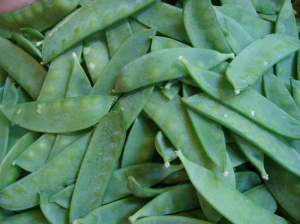 Sugar Pea, Shelling, or Sugar Snap: Pods should appear just full of peas. Sample the crop as it matures because you want to pick when peas are mature but still sweet and tender. Overripe pea pods will appear leathery and dull.
Sugar Pea, Shelling, or Sugar Snap: Pods should appear just full of peas. Sample the crop as it matures because you want to pick when peas are mature but still sweet and tender. Overripe pea pods will appear leathery and dull.
Snow or Edible-Podded: Wait until the pod has reached its full length as indicated on the seed packet; it will begin to swell and show traces of small peas inside. Sample the crop as it matures in order to avoid harvesting too late, when they can get tough.
See our June issue for more information on harvesting asparagus, beets, lettuce, radish, rhubarb, spinach, Swiss chard, and turnip.
Maine Public Gardens: Garland Farm, Bar Harbor, ME
By Stephanie Burnett, Associate Professor of Horticulture at the University of Maine
Open days for Garland Farm are Thursdays from 1:00-4:00 pm, from June 23 through September 22. Entrance to the garden is free, but a $5 donation is suggested for visitors.
Garland Farm in Bar Harbor is a wonderful place to get a sense of the history of gardens in Maine and see some unusual plants. It was the last home and garden of renowned landscape architect, Beatrix Farrand. She was a founding member of the Landscape Architect’s Society of America and worked at a time when it was unusual for women to be prominent in the field. She designed many notable gardens throughout the United States. Her impact on the gardens in Bar Harbor was profound since she spent summers there every year at Reef Point, her original home and garden. Some examples of her gardens include the Abby Aldrich Rockefeller Garden in Seal Harbor, ME; Bar Harbor Village Green in Bar Harbor, ME; Peggy Rockefeller Rose Garden at the New York Botanical Garden in Bronx, NY; Dumbarton Oaks in Washington, D.C.; and the Rose Garden at the White House. A list of additional projects she worked on may be found in ‘Beatrix Farrand: Private Gardens, Public Landscapes’ by Judith B. Tankard.
- Figure 1
- Figure 2
Figures 1 and 2: The terrace garden at Garland Farm in Bar Harbor is full of English lavender, heath, and heather in raised beds edged with slate tiles.
This special, but somewhat hidden, garden allows you to see a space that Beatrix Farrand designed for herself late in life. Visitors can tour her former home, a library of important horticultural works, and her lovely garden. The Beatrix Farrand Society conserves and maintains her home and garden at Garland Farm. Highlights include an entrance garden and a terraced garden adjacent to the house. The entrance garden includes boxwood (Buxus sp.) lining the path to the house, and several unusual native plants. There is always two potted rosemary (Salvia Rosmarinus) plants on the path to the main house today, as when Farrand lived there. The terrace garden is planted with lavender and a unique collection of heather (Calluna sp.) and heath (Erica sp.) plants in raised beds (Figures 1 and 2). A variety of vines, including clematis, grow on
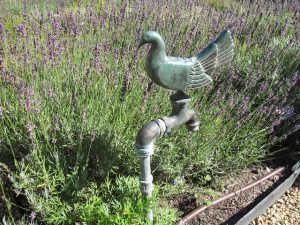
restored fences that encircle the terrace garden. Throughout the garden, there are details that show Beatrix Farrand’s care for this space. Some are whimsical, such as a bird topping a hose bib in the terrace garden (Figure 3), while some are more practical, such as the long-lasting, slate edging on many beds. Many of these plants and garden features were moved to Garland Farm from Farrand’s garden in Reef Point. No matter when you visit during the season, there will be something in bloom. In July, you can see the flowers on the lovely flowering tree, Stewartia koreana (Korean Stewartia), or the large collection of irises. A bloom calendar that provides examples of what you can expect when you visit is found here, Beatrix Farrand Society.
One of Beatrix Farrand’s goals was to support the education of other horticulturalists, landscape architects, and gardening enthusiasts. The Beatrix Farrand Society honors and continues her work through a variety of educational events. Each summer, visitors can view vouchers of herbarium specimens in the large barn at Garland Farm. These vouchers were created from herbarium specimens (dried plant samples) that meticulously document plants from her garden at Reef Point. During the summer, the Beatrix Farrand Society also hosts educational programs, most of which are in the barn at Garland Farm. The full list for this season may be found here, Programs at Garland Farm. Most events are $10 for members of the society or $20 for non-members; however, there are two free events each summer. This year, these include a lecture with landscape designer Dan Pearson on August 11 and a lecture with Farrand Scholar and author, Judith Tankard, on August 6.
If you plan to visit the garden, here are directions.
Northern Mockingbird
By Doug Hitchcox, Maine Audubon Staff Naturalist
Northern Mockingbirds are well-known for their range and colorful vocal repertoire. This slender gray-bodied bird can be heard calling incessantly throughout the day, often stringing together the songs of different birds into one endless monologue. They sometimes harass other birds as well, not only by “mocking” their calls but by intruding upon nesting sites. Northern Mockingbirds are fiercely protective of their own nests, territory, and young. Predators risk being mobbed and chased should they come too close to nestlings or protected grounds. If you watch a mockingbird on the ground for even a short period of time you may see it abruptly stop and then lift its wings, flashing the patch of white underneath, and raising the wings in erratic movements. Considered an anti-predatory display, it demonstrates how aggressively the mockingbirds protect their own.
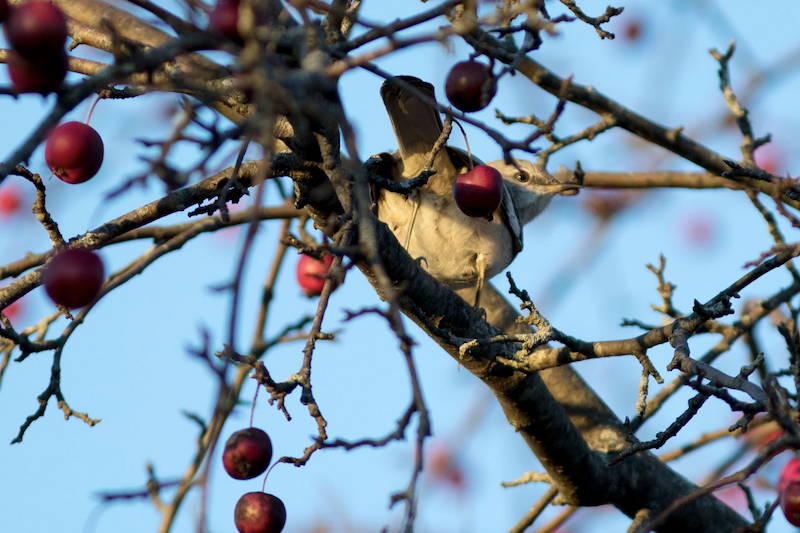
For more on the importance of Maine native plants to support birds and other wildlife, visit Maine Audubon’s “Bringing Nature Home” webpage.
PFAS and Your Home Garden
By Rebecca Long, Sustainable Agriculture, and Food Systems Professional
Since PFAS hit the news this spring we’ve been receiving lots of questions from home gardeners about the potential impacts of PFAS on their gardens.
PFAS refers to a whole group of man-made chemicals (per- and polyfluoroalkyl substances) that have been used since the 1940s in household products and industrial settings. They are used mainly for their ability to repel oil, grease, water, and heat. Due to their widespread use, PFAS have made their way into our waste stream. Since the 1980s, sludge from waste treatment facilities has been used on farms as a low-cost fertilizer and in some soil and compost products marketed to home gardeners.
PFAS are very resistant to breaking down in the environment, hence the name “forever chemicals”. Therefore they have remained in the soil, been taken up into plants, and made their way into animals who eat those plants. In some cases, they have also leached into both surface and groundwater.
Recently there has been growing concern about our exposure to PFAS because two of the better studied PFAS compounds (PFOA and PFOS) have been shown to cause human harm in relatively small quantities.
It’s important to keep in mind that we are exposed to PFAS from a variety of sources in everyday life. Stain-resistant carpeting, nonstick cookware, grease- and water-proof food packaging, fabric softeners, waterproof clothing, cosmetics, and many other products contain this class of chemicals. Exposure to PFAS via produce from our gardens likely represents a small fraction of our exposure.
The questions gardeners most frequently ask are: “are there PFAS already present in my soil” and “does a product I’m considering using contain PFAS?”
Because of the difficulty of collecting uncontaminated samples and the expense of testing (~$400), gardeners may want to consider investigating the history of their garden before testing. If you choose to test soil, a list of Maine Laboratories that Subcontract Residential PFAS Analysis for Water and Soil (PDF) (Maine.gov website) is available. The UMaine Soil Lab does not currently test for PFAS. Keep in mind that results will be difficult to interpret since there are currently no guidelines available for what levels of PFAS in garden soil and irrigation water are acceptable.
Being conscientious of what amendments you add to your garden is important not just because of potential contaminants like PFAS, but also the potential to introduce invasive plants and insects to your garden. The best source of information is the manufacturer or distributor of the product you are considering, be it compost, topsoil or manure-based fertilizers.
If this has left you with more questions than answers, you’re not alone. PFAS research is in the early stages and will take time as labs get up and running with equipment sensitive enough to detect PFAS at the low levels we need (parts per billion or even parts per trillion). With ongoing collaboration from educational, nonprofit and government groups, Maine is on the forefront of tackling this issue, although it is not unique to our state.
If you have questions, please start by reading through the FAQ’s on our Understanding PFAS and Your Home Garden page:
-
-
- What are PFAS and Where Did They Come From?
- Are There PFAS Compounds Already in My Garden?
- Can I Test My Water for PFAS?
- What Can I Do If My Water is Contaminated with PFAS?
- Can I Take a Soil Test to Check for PFAS in My Garden?
- What Can I Do if My Soil is Contaminated with PFAS?
- Do the Amendments I Buy (Composts and Fertilizers) Contain PFAS?
- Should I Eat Produce Grown in My Garden?
-
Contact information for any other PFAS-related questions:
For gardening-related PFAS questions:
University of Maine Cooperative Extension
Email: extension.PFASQuestions@maine.edu
Phone: 207.581.3188, 1.800.287.0274 (in Maine)
For health-related questions:
Maine Center for Disease Control and Prevention (CDC):
Email: pfas.mecdc@maine.gov
Phone: 207.287.8016
For concerns about your residential well, and spreading record details for your property:
Maine Department of Environmental Protection (DEP):
Tracy Kelly, Public Service Coordinator
Email: pfas.dep@maine.gov
Phone: 207.480.0583
Do you appreciate the work we are doing?
Consider making a contribution to the Maine Master Gardener Development Fund. Your dollars will support and expand Master Gardener Volunteer community outreach across Maine.
Your feedback is important to us!
We appreciate your feedback and ideas for future Maine Home Garden News topics. We look forward to sharing new information and inspiration in future issues.
Subscribe to Maine Home Garden News
Let us know if you would like to be notified when new issues are posted. To receive e-mail notifications, click on the Subscribe button below.
University of Maine Cooperative Extension’s Maine Home Garden News is designed to equip home gardeners with practical, timely information.
For more information or questions, contact Kate Garland at katherine.garland@maine.edu or 1.800.287.1485 (in Maine).
Visit our Archives to see past issues.
Maine Home Garden News was created in response to a continued increase in requests for information on gardening and includes timely and seasonal tips, as well as research-based articles on all aspects of gardening. Articles are written by UMaine Extension specialists, educators, and horticulture professionals, as well as Master Gardener Volunteers from around Maine. The following staff and volunteer team take great care editing content, designing the web and email platforms, maintaining email lists, and getting hard copies mailed to those who don’t have access to the internet: Abby Zelz*, Annika Schmidt*, Barbara Harrity*, Cindy Eves-Thomas, Kate Garland, Mary Michaud, Michelle Snowden, Naomi Jacobs*, Phoebe Call*, and Wendy Roberston.
*Master Gardener Volunteers
Information in this publication is provided purely for educational purposes. No responsibility is assumed for any problems associated with the use of products or services mentioned. No endorsement of products or companies is intended, nor is criticism of unnamed products or companies implied.
© 2022
Call 800.287.0274 (in Maine), or 207.581.3188, for information on publications and program offerings from University of Maine Cooperative Extension, or visit extension.umaine.edu.
The University of Maine is an EEO/AA employer and does not discriminate on the grounds of race, color, religion, sex, sexual orientation, transgender status, gender expression, national origin, citizenship status, age, disability, genetic information or veteran’s status in employment, education, and all other programs and activities. The following person has been designated to handle inquiries regarding non-discrimination policies: Director of Equal Opportunity, 101 North Stevens Hall, University of Maine, Orono, ME 04469-5754, 207.581.1226, TTY 711 (Maine Relay System).

